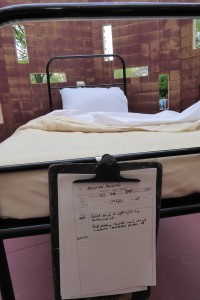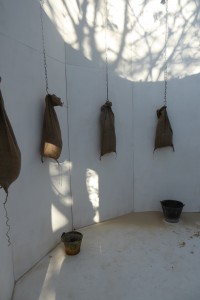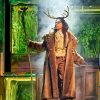A unique project that has grown from an initial meeting with the director Ajay Chhabra on a 14-18Now research trip to Flanders into part of a 10 hour immersive experience in the garden of the Royal Pavilion in Brighton for Brighton festival. The day hopes to commemorate and dramatise the experiences of the 2300 Indian soldiers who were hospitalised in 1914 in the Brighton pavilion which was converted for the purposes into what must have been a very surreal environment for the soldiers. I have designed three ‘pavilions’ within the Gardens as a response to the images of the Hospital created within the extraordinary interiors of the Pavilion. We have tried to imagine what it would have felt like to wake up in this environment , the feelings of loneliness and home sickness of men thrust into a strange exotic building, which we are sure the authorities felt would make them feel at home, yet in-prisoned and shielded them from the inquisitive Brighton public.
The bed head pavilion provides an open stage for performance and also acts as a growing memorial to the 2300 soldiers who passed through the hospital.It was inspired by watching film of soldiers carrying piles of bedheads into the Dome, and from looking at the architectural drawings of the Brighton pavilion itself. It also houses the Scribe whose letters home capture the pain and homesickness of the men.We have found as many old photographs as possible and , although we don’t know their names , have tried to create a memorial to the men who suffered here.There are over 2000 of whom we don’t have an image, so we have used a cropped photograph of the back of an unknown soldier to represent those of whom we have no record and are inviting the public to add their thoughts to create a memorial within the pavilion.
The red and gold pavilion houses a single bed, is open to the sky and we hope gives a sense of the strange confinement and intense scrutiny the soldiers must have felt.
The white pavilion is an installation in response to images of the operating theatre and Halal food preparation required to feed the men. The great irony of the hospital was that the men were being patched up to return to the butchery of the front, something that the sanitised photographs with all sense of pain or horror removed try to make us forget.
Over the course of the day there are a series of pop up theatrical intervention when a cast costumed by my Co designer Amanda Stoodley animate the spaces with fragments of scenarios (written by Stephen Clark, directed by Sian Williams). Then as dusk draws in the sound design of Thor McIntyre and lighting by Phil Supple transform the pavilions into installations in which the public can wander and contemplate while watching the cast lay out 2300 hand made clay Diyas ,which local school children have made , on the lawn in front of the Pavilion.
The visual highlight of the evening is the video mapping and projection by Novak, which animates the front of the pavilions magnificently.
The final moment is an indian soldier caught high on the dome playing his flute a mournful tribute to those who suffered.

















Leave a Comment